Buying Antique Sewing & Work Tables: A Complete Guide
Though originally made specifically for sewing, needlework and other domestic tasks, antique sewing and work tables are now appreciated as multi-purpose pieces with real decorative and functional value. Their convenient size, purposeful form and often ingenious storage make them a smart addition for modern homes, especially where space or subtlety is key.
Most are made in fine timbers such as mahogany, walnut, rosewood or satinwood, chosen as much for visual impact as durability. Many feature well-figured veneers, original fitted interiors and distinctive design details like carved decoration, drop-leaf tops and integrated drawers.
This guide covers the main types of antique sewing and work tables you’ll encounter, how to identify quality examples and what to consider when buying. Whether chosen for their utility, presence or provenance, understanding the key features and variations can help you make a more confident and informed decision.
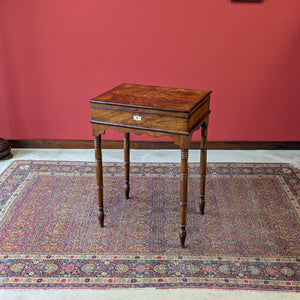
Sewing Tables & Work Tables: What Sets Them Apart
Antique sewing tables and work tables are often grouped together for good reason, as they share many similarities in appearance, scale and intended purpose. But they were originally designed for quite different uses in the home, so understanding their distinctions can help you choose a piece that suits your space and how you plan to use it.
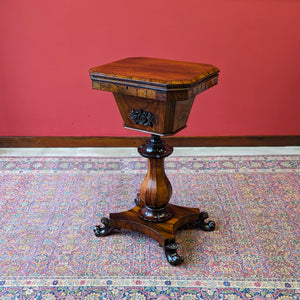
Sewing Tables: Purpose-Built for Needlework
Sewing tables were created specifically for handwork and embroidery. Typically made for women, they generally feature fitted interiors with divided compartments for threads, needles, thimbles and small tools. Many include a larger lower storage section in the form of a shaped drawer or hanging fabric bag, designed to hold ongoing needlework.
They tend to be slightly more delicate in scale and decoration than general-purpose furniture, with refined proportions and a feminine sensibility common to 19th-century domestic design. Sewing tables usually have a hinged top and internal layouts that prioritise storage for small, specific items.
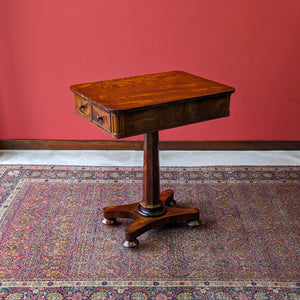
Work Tables: Multi-Use Domestic Furniture
Work tables served a broader domestic role than sewing tables. They were designed not just for sewing but for a range of tasks like writing, reading, sorting papers or storing small items. Unlike sewing tables, they may have plain interiors, shallow drawers or occasionally writing slides, sometimes with no fitted compartments at all.
Work tables are often more robust in construction and varied in form. They may resemble small writing tables, Pembroke tables or side tables in their silhouette, with square, circular or drop-leaf tops. The key difference is that their function wasn’t limited to needlework; they were made to serve, in a general sense, wherever extra surface or storage was useful.
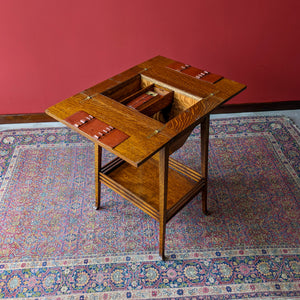
How Work Tables & Sewing Tables Differ from Other Antique Tables
What sets sewing and work tables apart from other antique forms is their intended domestic intimacy. They were made not for dining, display or storage at scale, but for personal use, often by women, often in private or semi-private settings like the bedroom or drawing room.
They are smaller than most side tables, more specialised than occasional tables, and finer in scale and layout than typical writing tables. A true sewing or work table will usually reveal its purpose through both its outward form and internal configuration. While they can now serve many roles in today’s homes, their original character lies in their quiet usefulness and considered details.
Typical Features of Antique Sewing & Work Tables
Antique sewing and work tables share several common features, but each type also has its own distinctive characteristics. In this section, we’ll walk through the main details found across the two categories, so you know what you’re looking at, and can more easily figure out which elements might actually be useful in your home.
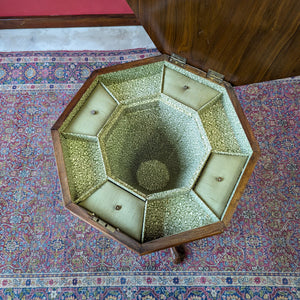
Fitted Interiors
Most sewing tables include a compartmentalised interior beneath a hinged or lift-up lid. These sections were used to store threads, needles, thimbles and other small sewing tools. Some examples include removable trays or lidded sections, often lined with velvet, silk or decorative paper.
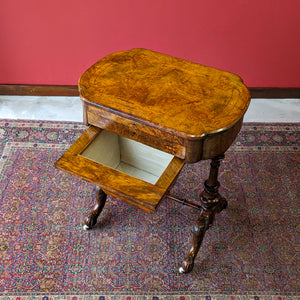
Work Bags & Lower Storage
A signature feature of many sewing tables is the fabric work bag or pull-out basket suspended beneath the tabletop, used to hold needlework in progress. Others may have shaped lower drawers or storage wells built into the base. These are often delicately integrated into the form and can be key indicators of a table’s original purpose.
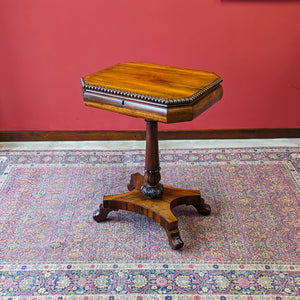
Compact Proportions
Both sewing and work tables are modest in scale, typically a similar size or smaller than an occasional table and considerably smaller than a side table or writing table. Their dimensions were designed for personal use, often while seated, and they were intended to occupy a quiet corner of a room elegantly when not in use.
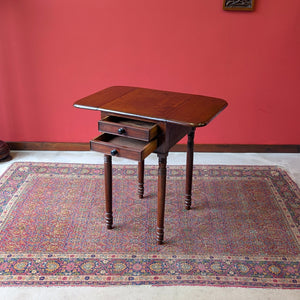
Functional Tops
Tops may be fixed, hinged or fitted with drop leaves. Work tables more often feature drop-leaf extensions, while sewing tables typically conceal storage within a hinged lid. In some cases, the tops are veneered with burr, inlay or even tooled leather, though plain timber tops are more common.
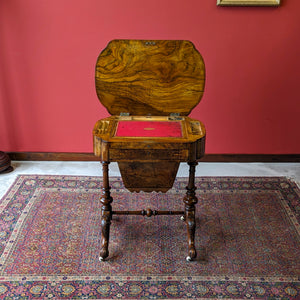
Slides, Pull-Out Work Surfaces or Writing Slopes
Some work tables include sliding extensions or pull-out work surfaces which can temporarily expand usable space. These can take the form of simple pull-out slides, lidded compartments, or fold-out leaves, and were often designed to make the table more adaptable for reading, sorting papers or small domestic tasks.
Occasionally found in both work tables and sewing tables are adjustable writing surfaces or writing slopes, sometimes with inset tooled leather. Their presence reflects how personal correspondence was once an integrated part of daily life, neatly accommodated within these multi-functional pieces.
How Antique Sewing & Work Tables Fit into Contemporary Homes
While originally made for domestic tasks such as needlework, correspondence and other domestic clerical tasks which play a smaller role in modern life, both antique sewing tables and antique work tables remain surprisingly useful today. Their smaller format, purpose-led design and built-in storage make them well suited to modern living, especially in rooms where space is limited or versatility matters.
Their drawers, lift-top compartments or fitted interiors provide just enough storage for small, useful things, without the bulk of larger furniture. For those furnishing period properties, they blend particularly effortlessly with other antique pieces. In more contemporary homes, they offer warmth, tactility and subtle contrast, a combination that works precisely because of their modest scale and decorative character.
What sets them apart isn’t just their size, but their sense of purpose. Each was made with function in mind, and that intention still holds in a modern context. Whether holding keys and letters, storing remote controls or simply sitting quietly in a corner, these tables add character while earning their keep.
They’re also well suited to storing supplies for modern hobbies, whether it’s embroidery, papercraft, knitting or anything else that benefits from shallow compartments and a tidy, dedicated space.
There’s no shortage of other roles these multi-functional pieces can play. They can work beautifully as understated bedside pieces, offering a useful surface and discreet storage. They also serve well as occasional tables as most were designed with similar mobility in mind, intended to be moved into position as needed. The difference is that they offer far more storage and utility, which can make a meaningful difference if that’s what your space calls for. Where space is limited, they make practical hall tables or can even stand in as side tables, especially where a small footprint and a touch of storage are the key requirements.
Antique Sewing & Work Table FAQs
What’s the difference between a sewing table and a work table?
Sewing tables were built for needlework, with fitted interiors. Work tables were more general-purpose and varied in layout.
Can antique sewing tables still be used today?
Absolutely. Their compact scale, purposeful design and discreet storage make them surprisingly relevant for modern living, especially where space is limited.
What woods are antique sewing tables made from?
Common timbers include mahogany, rosewood, satinwood and walnut, often with particularly decorative veneers.
Can antique work tables or sewing tables be used as bedside tables?
Certainly, they work especially well where space is limited and some hidden storage is useful.
Were these tables only made for women?
Sewing tables were traditionally designed for women, but work tables were more general domestic furniture. Today though, these can make incredibly useful pieces of furniture for anyone.
Can they be used in hallways or landings?
Yes, their small footprint makes them perfect for narrow spaces where a full console won’t fit.
Do they always have storage inside?
Almost always. That’s one of their defining features, whether in trays, drawers or hidden wells.
Are they easy to move around the house?
Yes. Most were made with portability in mind and are light enough to reposition easily.
What’s the best room for a sewing or work table?
Bedrooms, sitting rooms, studies or hallways, anywhere you want useful storage in a small space.
Do they work in modern interiors?
Most definitely, their scale and subtle detailing contrast beautifully with clean, contemporary spaces.
Can they be used as lamp tables?
Definitely. Their height and surface size make them ideal for lamps, books or small displays.
Can I view a table before buying to make sure it suits my needs?
Absolutely, simply get in touch to arrange a private viewing.
Antique sewing tables and work tables offer more than charm, they’re genuinely useful pieces with a clear sense of purpose. Whether made for needlework or broader domestic tasks, their compact form, considered storage and refined detailing still makes sense in today’s homes.
If you’re looking for a small piece with character, function and lasting quality, this is a category worth exploring. Browse the collection or get in touch, we’re always happy to help you find the right piece.












